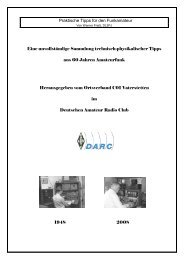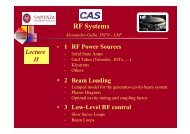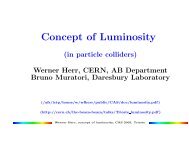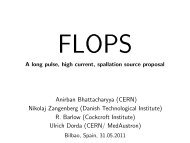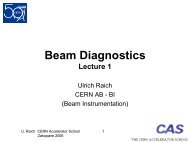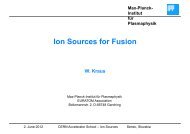mode - CERN Accelerator School
mode - CERN Accelerator School
mode - CERN Accelerator School
Create successful ePaper yourself
Turn your PDF publications into a flip-book with our unique Google optimized e-Paper software.
(v/c)^2 (<br />
1<br />
Proton and Electron Velocity<br />
electrons<br />
“Einstein”<br />
protons<br />
0<br />
0 100 200 300 400 500<br />
Kinetic Energy [MeV]<br />
β2 =(v/c) 2 as function of kinetic<br />
energy T for protons and<br />
electrons. l t<br />
Relativistic (Einstein) relation:<br />
2<br />
T = m 0 0c<br />
(<br />
1<br />
2<br />
1−<br />
v<br />
2<br />
−1<br />
) = m0c<br />
( γ −1<br />
)<br />
2<br />
0 γ<br />
c<br />
Classic (Newton) relation:<br />
2<br />
2<br />
v<br />
2 1 v<br />
T = m0<br />
= m0c<br />
( ) 2<br />
2 2 c<br />
→ Protons (rest energy 938.3 MeV): follow “Newton” mechanics up to some tens of MeV<br />
(Δ (Δv/v / < 1% for f W < 15 MeV) M V) then th slowly l l become b relativistic l ti i ti (“Ei (“Einstein”). t i ”) FFrom th the GGeV V<br />
range velocity is nearly constant (v~0.95c at 2 GeV) → linacs can cope with the<br />
increasing particle velocity, synchrotrons are more efficient for v nearly constant.<br />
→ Electrons (rest energy 511 keV, keV 1/1836 of protons): relativistic from the keV range<br />
(v~0.1c at 2.5 keV) then increasing velocity up to the MeV range (v~0.95c at 1.1 MeV)<br />
→ v~c after few meters of acceleration in a linac (typical gradient 10 MeV/m).<br />
3



